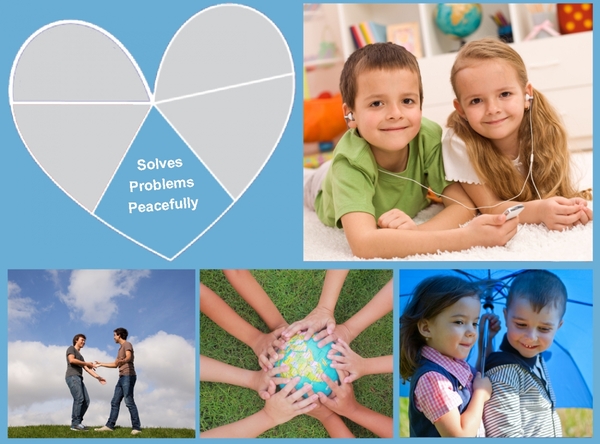Heart-Mind Challenge: Solving Problems Peacefully


What is the quality?
Learning to solve problems peacefully involves many social and emotional skills and is strongly linked to the quality of “getting along with others.” Unlike conflict avoidance, compliance, disengagement or coercion, solving problems peacefully means using empathy, problem-solving skills, understanding other points of view and actively coming up with strategies to make things right in a fair way.
Conflicts are a part of life and show up in situations where facts, desires, and fears differ between people. Simply put, conflict is a disagreement but it does not always involve a fight. Managing conflict effectively is about creating an atmosphere where violence and aggression are not likely to occur.
What does solving problems peacefully look like?
The strategies that children and youth use to resolve conflict change as they grow up. Stages of brain development are highly influential to both how children approach conflict and to the kinds of support adults can offer to build skills.
A child who has this quality is usually able to create an atmosphere of safety. They are able to put themselves in someone else’s shoes and they are able to manage their emotions. All children encounter challenging situations but children with this quality are usually able to problem solve peacefully and demonstrate respect for others. They do not start physical fights, bully, they are not mean to others and they do not laugh at other children’s discomfort. They can also listen attentively.
Children and adolescents who feel secure in their relationship with a parent/caregiver and know they can count on them are more confident, deal with stress more easily, become involved in fewer problem behaviours and actually hold their ground and say no to friends when asked to do things that are not safe or right. They do better in school and feel more confident going out into the world and making it their own.
What does it look like when this quality is diminished?
When this quality is diminished children can behave in an aggressive way – getting into fights, being mean, taking things away from others or making fun of them. They have limited skills in managing conflict and have difficulty with empathy. Often, they see hostility in situations where there is none. Expressing compassion towards others can be challenging.
Conflict can be a stressor for children and may lead to depression, anxiety or aggression if they lack the quality of outer-peace.
Why is it helpful/useful to have this quality?
Children who are better able to solve problems, get along with others and create a positive atmosphere. Just as stress can be “contagious,” so, too, can peace. The goal of peace is more than the absence of conflict and violence, it is recognizing and acting on the worth of self, others and our interconnectedness as humans.
There are several things that adults can do to promote effective problem-solving during the various stages of development. Remember, just like learning another language or a skill, problem-solving takes practice so rather than jump in and tell a child or adolescent how they should solve the problem, give them space to generate ideas and guide them through a process of evaluating possible solutions and then the outcomes of their solutions. Provide children and adolescents with positive support so that they see problem-solving as a skill that requires ongoing practice. Help them see difficulties in problem-solving as learning opportunities rather than failures. Finally, even when they don’t solve problems in ways that align with how they want to be as a person, teach them that they can always ‘go back’ (e.g., apologize, talk through the situation etc.) and try again in order to resolve problems in a way that leads them to feel higher levels of competence.
Try a few of the following actions to promote solving problems peacefully in your home, school or community.
![]() Understand the Brain.
Understand the Brain.
![]() Exercise your pre-frontal cortex; the area of the brain that keeps you calm in conflict.
Exercise your pre-frontal cortex; the area of the brain that keeps you calm in conflict.
![]() Identify and play with feelings words.
Identify and play with feelings words.
![]() Teach a problem-solving model.
Teach a problem-solving model.
|
For older youth, promote more complex thinking and evaluation of solutions and outcomes – weigh the pro’s and con’s; explore options, research possibilities, reflect on the process.
|
![]() Role Play Difficult Conversations.
Role Play Difficult Conversations.
It is important to provide children and youth with opportunities to role-play conflict resolution scenarios in order that they can practice skills.
Of interest is that when children and youth are given hypothetical situations in which they are asked to problem solve, they are more likely to use negotiation but in real life situations, they are more likely to use coercion. However, as adolescents mature, the use of negotiation in hypothetical and real life situations becomes more consistent.
![]() Create a Safe Space.
Create a Safe Space.
Create a safe space to have difficult conversations. Learn from Restorative Justice practices to take a relationship-based approach.
Check out this video presentation by researcher Brenda Morrison.
![]() Let fiction be our guide to solving problems peacefully.
Let fiction be our guide to solving problems peacefully.
Have fun with these stories that help children see conflict in new ways.
Engage a teen to talk about a movie, TV show or YouTube video that is an example of problem-solving peacefully.
Challenge Book recommendations from a Children’s Librarian, Vancouver Island Regional Library.







Comments
Post new comment